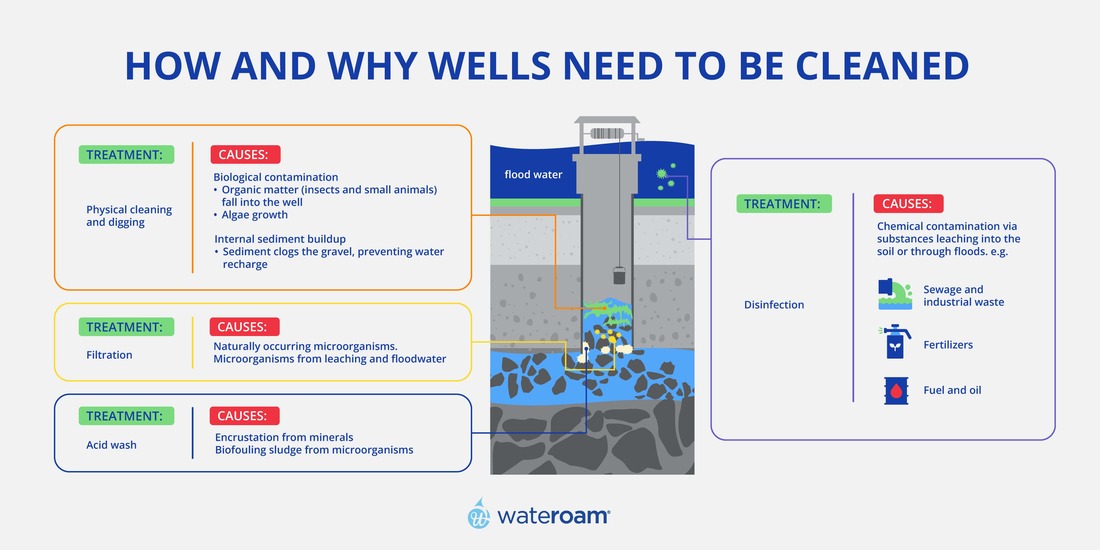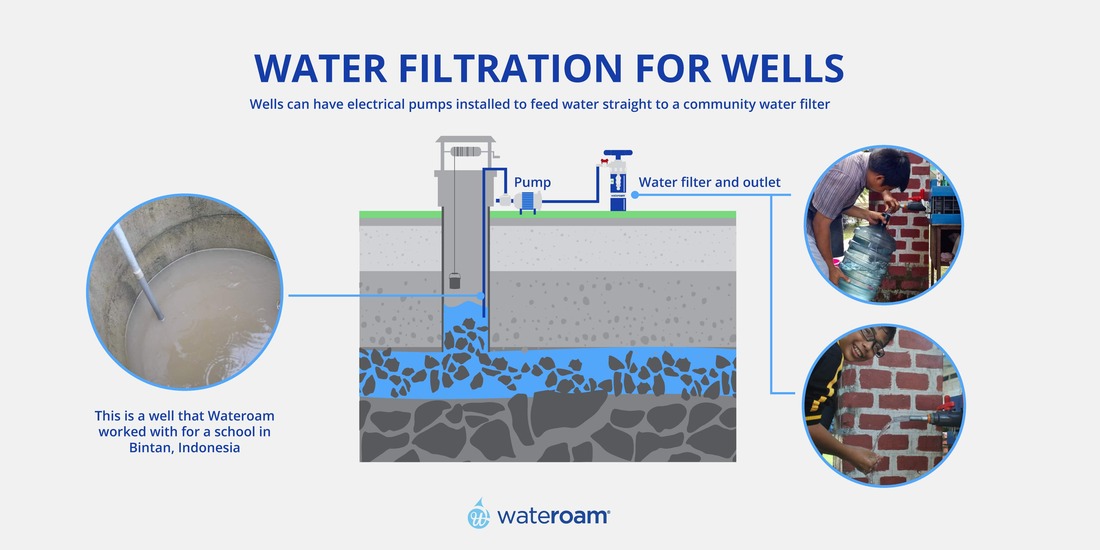Well Water Cleaning and Filtration Guide: Southeast Asia
In Southeast Asia, groundwater is a major source of clean drinking water for many communities, and wells are a primary way for them to access it.
However, without sufficient maintenance and care, multiple issues affecting the water supply could occur. Sedimentation can clog the wells and contaminants can leach into the water table endangering those who depend on the well for water. This article aims to provide an overview of why wells need maintenance and how to do so. We hope that this will be helpful for your organisation’s next rural development project. Groundwater Usage in Different RegionsSoutheast Asia
A 2019 study focused on groundwater usage in a few countries found that populations in Indonesia, Laos, Myanmar and Timor-Leste greatly depend on groundwater in both urban and rural settings (1).
While urban areas have better infrastructure such as plumbing and large-scale water purification facilities, rural areas have to rely on methods such as digging wells to access groundwater. This is particularly the case in rural communities in Indonesia, Myanmar and Timor-Leste who depend more on groundwater. Rural and Urban Areas in Selected Southeast Asian Countries
From a 2019 study that uses 2015 Socio-Economic Survey (SES) data - source: MDPI - Carrard, Foster, Willetts https://doi.org/10.3390/w11081605 (2)
Note: Case study countries where piped water in urban areas was found to be wholly or substantially drawn from groundwater included Solomon Islands, Vanuatu, Kiribati and Timor-Leste with 94%, 68%, 67% and 65% respectively of urban households using piped water drawn from groundwater sources. Countries where packaged water in urban areas was found to be wholly or substantially drawn from groundwater included Lao PDR, Indonesia and Myanmar, with 64%, 46% and 34% of households respectively using packaged water sourced from groundwater.
There is a lot of room for improving rural communities’ access to clean water, especially among Southeast Asian nations, especially since there are large proportions of their populations that lack access to safely managed drinking water.
UNICEF: Proportion of Population Using Safely Managed Drinking Water Services in Southeast Asia 2022
Source: Unicef 2022(3)
With this in mind, we’ve put this guide together to help provide your team with resources they can use in your next well water project.
Types of Wells
Wells are essentially pits or holes dug into the earth to reach a water table. There are various types of wells, but they fall into 3 broad categories: (4,5)
1. Open Wells or Dug Wells
These wells are excavated by hand shovel and backhoe until water can be accessed. The well is then lined with stones, brick, tile, concrete, or other material to prevent the well structure from collapsing.
As open wells are dug by hand, they can only as deep as the surface of the water table. This is because once they reach the water table, the water will erode nearby soil which impedes further progress. On average, open wells are around 15 metres deep and considered shallow wells. Shallow wells are more susceptible to contamination as there is not enough soil thickness to absorb more contaminants. 2. Driven Wells
These are constructed by driving a small-diameter pipe with a well point into shallow water-bearing sand or gravel. Driven wells are usually driven by hand and are only able to tap shallow water. This type of well on average tends to be 10 - 15 metres deep/ 30 - 50 feet deep.
Some aquifers consist of water-permeable sand and gravel that are harder to excavate by hand compared to digging out soil to reach pools of groundwater like with dug wells. In cases like these, driven wells are better suited to the task. 3. Drilled, Bored, or Borehole Wells
(6)Drilled wells are constructed through machinery, such as percussion or rotary drilling. Wells bored with a boring machine are known as bored or borehole wells. These wells can be drilled deeper into the ground compared to dug and driven wells to improve access to safer and cleaner groundwater sources.
With the help of machinery to drill or bore through the ground, wells can reach depths of 30 to 300 metres. As the hole bored can reach depths beyond the surface of the water table, these wells have access to more water. Borehole wells have access to cleaner water as there is more soil thickness to absorb contaminants from the water before it reaches the aquifer. Rural communities in Southeast Asia tend to have open wells or borehole wells with hand pumps. (7) Basic Components of Wells
As we’ve seen above, wells differ in multiple ways such as how they are dug, their depth,
and how the water is drawn. On the other hand, wells have these basic components(8): 1. Well casing
Dug wells without casings can collapse, burying access to the water again. Casings are inserted to provide the well with structure. These casings are usually made of sturdy material such as pipes (e.g. carbon steel, plastic, stainless steel) or concrete rings with grout.
Grout usually consists of a mixture of cement, water, and sand to prevent water from escaping through the concrete rings of the well casing. 2. Well screens and/or gravel packs
The bottom of the well casing or pipe has insufficient surface area for water to seep from the aquifer or water-bearing sand into the well. Well screens and gravel packs are ways to increase that surface area that can draw water from the aquifer.
Well screens are attached to the bottom of the casing to prevent too much sediment from entering the well, especially for wells accessing water in unconsolidated material. These are then surrounded by gravel packs. Well screens need to be slotted to let water enter, such as slotted PVC pipes or steel pipes. In addition to increasing the surface area, well screens and gravel packs also block excessive sediment from entering the well. This blocks impurities from entering the well and prevents the well from getting clogged too quickly. For driven wells, the well point serves two purposes: as a sharp point to help drive the pipe into the ground and as a well screen to draw water into the well. Why Wells Get Contaminated and How to Clean Them
There are multiple sources of well water contamination, such as biological contamination, sediment buildup and encrustation, and even chemical contamination.
The following signs indicate that your well needs a clean-up (9):
Different steps can be taken to purify different pollutants in well water so that it meets minimum water quality standards. You can also find out more about these standards in our blog post on WaSH and water quality standards. Cause: Physical Contaminants - Biological Contamination and Sediment Buildup
Dug wells in rural areas tend to have big uncovered openings which can allow pollutants to enter the well. These include organic matter like insects, animal droppings, leaves and dirt.
Over time, algae can also grow in well water that is exposed to sunlight. These can grow into harmful algal blooms which contain cyanotoxins. (10) When the well water looks more turbid, a lot of sediment has likely built up on the well screen and the gravel packs. This sediment can form through mud, sand, and silt accumulating on the well screen and casing. (11) Apart from affecting its drinkability, densely packed sediment and encrustation will affect the well’s ability to absorb water from the aquifer, reducing water levels. Treatment: Physical Clean Up - Digging, Scrubbing and Other Methods
Physical pollutants in the well must be cleaned manually using tools like shovels, wire brushes and scrapers. The pollutants are then collected into buckets and lifted out of the well.
A driven well’s pipes are too narrow to be cleaned by hand but can have pressurised air pumped into the system to agitate and loosen physical particles. In some cases, driven wells may need to be re-driven or replaced. Before deciding what methods you should use to clean the well, it’s also best to inspect the condition of the well first. The well could be old and have a corroded well casing, which means that more aggressive cleaning techniques could damage the well. (12) Cause: Encrustation and Biofouling
(13) Encrustation can occur when scale or mineral deposits in mineral-rich water form crusts or coatings in and around the well screen. Encrustation can take different forms from hard and brittle deposits to soft sludge under different conditions. Encrustation in wells often comes with biofouling.
Biofouling refers to the clogging of water screens by slime deposits created by organisms in and around the well. Bacteria and other microorganisms can occur naturally in the ground or from improperly built sanitation systems. Treatment: Mechanical and Chemical Treatments
Treatment methods for encrustation require careful assessment of the type of well and its construction.
For encrustation on the well walls and on the inner side of well screen, physically scraping off the crust using wire brushes and scrapers works. The cleaned-off material can be lifted out of the well in buckets or bailed out. Crust and scale outside the well screen require chemical treatment like acid washes. Acid is pumped into the well and allowed to remain there for a set period depending on the size of the well, from a few hours to 15 hours. An inhibitor is used with the acid to limit damage to the pipes and the well casing. Common acids used include hydrochloric acid, sulfamic acid, and glycolic acid. We currently don’t provide acid wash treatment, but you can learn more about treating encrustation at this Inspectapedia resource. (14) Cause: Chemical Contamination via Groundwater Leaching
Shallow wells (15 metres/ 50 feet deep or less) do not have a lot of soil thickness to sufficiently absorb a lot of contaminants.
Nearby polluting sources such as farms or industrial areas can dump their chemicals near the wells which get leached into the groundwater. These chemicals can include pesticides, chemical fertilizers, sewage, industrial waste and even heavy metals like lead and more. If left untreated, these toxins can cause health issues ranging from cancer to hormone disruption and altered brain function. Pregnant women and children are especially at risk. (15) Treatment: Chemical Disinfection
Wells can also be disinfected to eliminate bacteria, viruses, and parasites. You can find a list of diseases prevented by disinfection at the USAID resource linked below. (16)
Disinfection is done by exposing the water to chemicals like chlorine, iodine, bleach, etc. for a while. This can be done at the well itself or at water outlets at the point of use. Wells that are deeper and wider need higher amounts of disinfectant. If the community you are serving requires disinfection for their wells, you can find detailed instructions for well disinfection on CDC’s website linked in the resources below. (17) Cause: Biological Contamination from Microorganisms
Microorganisms can occur naturally, especially in shallow wells. These contaminants can also leach in from nearby sanitation infrastructure.
These microorganisms include bacteria, parasites, helminths, protozoa, viruses, and cysts. If left untreated, biologically contaminated water can cause diseases such as diarrhoea. Childhood diarrhoea is one of the big killers of children worldwide. Treatment: Water Filtration
As water quality differs from place to place, it’s best to conduct a water assessment of the community’s water sources that you want to purify to determine which types of water treatment or water filters are required. Below is a list of filtration and chemical processes related to filtration
Physical filtration
Chemical Processes
You can find out more about these different filtration techniques on our water FAQ or contact our friendly team who can advise you on this here. Water which is full of physical particles and microorganisms is unfit for drinking or everyday use. If the water only requires removing these two issues, filtration might be sufficient for the community’s use. In these cases, a filter and a hand pump or electric pump to feed the water filter are installed into the well. Below is an example of how this can work for an open well.
Open wells can have filters and pumps directly installed into them. This is a well that
Wateroam worked with in Bintan, Indonesia
Borehole wells can have the filter connected to the spout or have a filter with a built-in hand pump installed in place of the original spout.
As an example of how filtration can help purify water in wells in rural communities, Wateroam worked with Canact Asia, an education and training enterprise, to provide one of our filters using ultrafiltration technology to improve their access to clean water. With ultrafiltration, the pore sizes are small enough that even some viruses are prevented from getting through. Ultrafiltration’s typical pore size is around 0.01 micrometre (µm) (1µm = 0.000001m). Filtering out these viruses means that ultrafiltration can defend against childhood diarrhoea which is one of the main killers of children under 5 in the world (18). Wateroam’s filter has been certified by WHO. You can check WHO’s certification and report here. The main source of water for Sekolah Tinggi Agama Islam (STAI) Miftahul Ulum in Bintan, Indonesia is from a few wells located around the school. Pumps and filters were attached to those wells to provide clean water for more than 150 residents. You can read more about this here. Items You’ll Need for Well Cleaning and Purification
Below is a basic list of items your team can use for your next rural development project involving well cleaning:
Items needed for physical cleaning:
Items needed for filtration:
Items needed for disinfection and/or acid wash:
Considering the range of disinfectants and that they need to be carefully measured before being applied to your communities well, we’ve provided the following resources that you can use:
Links to more resources:
You can refer to these resources for more detailed information on groundwater pollution, filtration and disinfection
We hope that you’ve found this guide and the links to other resources helpful and insightful. Wateroam is always ready to support humanitarian and rural development projects with our water filters and looks to support you in making a positive impact in the world. To find out more about our work and our products, reach out to us below:
(1) Carrard, Foster, Willetts - Groundwater as a Source of Drinking Water in Southeast Asia and the Pacific: A Multi-Country Review of Current Reliance and Resource Concerns
(2) Carrard, Foster, Willetts - Groundwater as a Source of Drinking Water in Southeast Asia and the Pacific: A Multi-Country Review of Current Reliance and Resource Concerns (3) Progress on household drinking water, sanitation and hygiene 2000-2022: Special focus on gender - UNICEF DATA (4) Types of Wells - Wellowner.org (5) Groundwater Wells | U.S. Geological Survey (6) Learn About Private Water Wells | US EPA (7) Self-supplied drinking water in low- and middle-income countries in the Asia-Pacific | npj Clean Water (8) Learn About Private Water Wells | US EPA (9) Residential Well Cleaning - Wellowner.org (10) Blue Green Algae in Drinking Water | NSF (11) Residential Well Cleaning - Wellowner.org (12) Well Treatment Techniques | The Driller (13) Water Pollution: Everything You Need to Know (14) Inspectapedia - Well Rehabilitation (15) WHO - Diarrhoeal disease (16) USAID - Disinfection for Rural Community Water Supply Systems in Developing Countries (17) Centers for Disase Control and Prevention - Disinfecting Wells After a Disaster | Water, Sanitation, & Hygiene-related Emergencies & and Outbreaks (18) WHO - Diarrhoeal disease
0 Comments
|
Want more?Click below to see what other blog topics might peak your interest! 


|
- About Us
- Products
- Solutions
- Resources
- Get Involved
-
Blog
- The Global Water Situation
-
Facts about Water
>
- Water supplies for crisis
- WaSH During Emergencies
- Well Water Cleaning and Filtration Guide: Southeast Asia
- Gravity-fed Water Systems: Water Purification and Filtration setups in Southeast Asia
- A Guide to Rural Rainwater Harvesting and Filtering
- Water Shortages and Their Effect on Children in Rural Schools
- WaSH Planning and Design Framework Resources for Indonesia and the Philippines
- Rural Community Water Supply: Water Systems in Villages
- Info on our Products
- Impact Stories
- Upcoming & Past Events
- Contact
- Store
- About Us
- Products
- Solutions
- Resources
- Get Involved
-
Blog
- The Global Water Situation
-
Facts about Water
>
- Water supplies for crisis
- WaSH During Emergencies
- Well Water Cleaning and Filtration Guide: Southeast Asia
- Gravity-fed Water Systems: Water Purification and Filtration setups in Southeast Asia
- A Guide to Rural Rainwater Harvesting and Filtering
- Water Shortages and Their Effect on Children in Rural Schools
- WaSH Planning and Design Framework Resources for Indonesia and the Philippines
- Rural Community Water Supply: Water Systems in Villages
- Info on our Products
- Impact Stories
- Upcoming & Past Events
- Contact
- Store





.jpg)